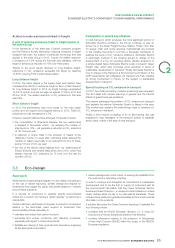APC 2012 Annual Report Download - page 59
Download and view the complete annual report
Please find page 59 of the 2012 APC annual report below. You can navigate through the pages in the report by either clicking on the pages listed below, or by using the keyword search tool below to find specific information within the annual report.
2012 REGISTRATION DOCUMENT SCHNEIDER ELECTRIC 57
SUSTAINABLE DEVELOPMENT
2
GREEN AND RESPONSIBLE GROWTH DRIVING ECONOMIC PERFORMANCE
Action plans
Schneider Electric’s approach to its suppliers in the area of
sustainable development centers around three main action plans.
Integration of the sustainable purchases approach
into the selection of new suppliers
Schneider Electric uses a qualifi cation process called Schneider
Supplier Quality Management to select new suppliers. It is based
on an evaluation questionnaire combined with on-site audits by
Schneider Electric quality specialists.
This process includes a specifi c section on the environment and
sustainable development and aims to assess supplier suitability
with regard to the Group’s aims in three areas:
•social responsibility linked to the Global Compact principles;
•environment: ISO14001, ISO14062 on eco-design, REACH and
RoHS;
•safety: health, safety standards, accidents and severity rate.
Sustainable development criteria account for nearly 15% of supplier
evaluation. In addition, all these criteria have a minimum level, below
which a supplier will not be retained to work with Schneider Electric.
Schneider Electric carried out more than 252 audits of this type
in2012.
This qualifi cation process applies to all new suppliers and to
existing suppliers in certain cases. It is strengthened by the General
Purchasing Conditions to which all suppliers must conform: OECD
directives on sustainable development and regulations defi ned in the
ISO14001 standard. Suppliers also commit to respect all national
legislation and regulations, the REACH regulation and the RoHS
directives, and, more generally, the laws and regulations relating to
prohibition or restriction of use of certain products or substances.
Promotion of a continuous improvement process
based on ISO26000
A statement on the importance of sustainable development is made
by the Group purchasing pilot to each major supplier of Schneider
Electric after the supplier has been trained in the approach. For
these suppliers, in2012 Schneider Electric began an approach that
is based on an evaluation carried out by a third party. This is to
promote the commitment of the supplier to a process of continuous
improvement based on ISO 26000, through improvement plans
supported by the provider.
The sustainable development goals have become one of the
7 pillars used to measure supplier performance since 2011; this
has the particular advantage of allowing the highest-performing
suppliers to become a ’recommended’, or for the best suppliers,
’preferred’ Group supplier. The performance resulting from the
external evaluation is one of the key points of this pillar. The Group
aims to engage 90% of its recommended suppliers in a process of
continuous improvement on this pillar.
Rollout of eco-responsible initiatives
Schneider Electric is rolling out several eco-responsible initiatives
with its suppliers.
For example, Schneider Electric has chosen to go further than the
European REACH and RoHS regulations. The approach is therefore
rolled out in the Group over the whole product portfolio and all
suppliers, regardless of their geographic origin.
Furthermore, Schneider Electric launched an update in 2011 to
the carbon impact analysis of company purchases in terms of its
carbon footprint. Schneider Electric has used this approach to raise
awareness of the importance of this subject among purchasers and
certain suppliers in the most relevant purchasing sectors.
Finally, by the very nature of its activity, the Group continually
encourages its ecosystem (including customers and suppliers) to
implement energy effi cient solutions.
Examples
A global workshop organized in 2012 for “preferred” suppliers
emphasized the importance that Schneider Electric places on
aspects linked to sustainable development. During this workshop,
Schneider Electric wanted to reward the highest-performing
suppliers, particularly in the Planet and Social Responsibility
category for which a trophy was awarded.
Another example is Schneider Electric’s commitment to support
the small and medium enterprises network. This support is given
through an approach to work adapted with certain suppliers. In
France, Schneider Electric is a major player of the International
SME Pact.
2.4 Our Principles of Responsibility
The Company is constantly interacting with all the stakeholders
throughout the world: its borders are expanding, its environment is
changing ever faster, its activities are becoming globalized and its
social responsibilities are growing.
Schneider Electric wants to reaffi rm its desire to respect the laws
and regulations in all the countries in which it works.
The challenge is to gain and maintain the highest confi dence of
its customers and – in a wider sense – of its stakeholders. To
support each employee in this approach, the Group emphasizes
the importance of placing responsibility at the heart of its corporate
governance.
The Group currently has around 140,000 employees worldwide.
Following the Group’s various acquisitions, it has been able to
integrate this exceptional professional and cultural diversity to its
advantage. Driven by Group values, the Responsibility & Ethics
Dynamics program forms the basis of common references.
Schneider Electric’s mission therefore takes its meaning from
engaging with individuals and organizations in order to help them
get the most from their energy.
























